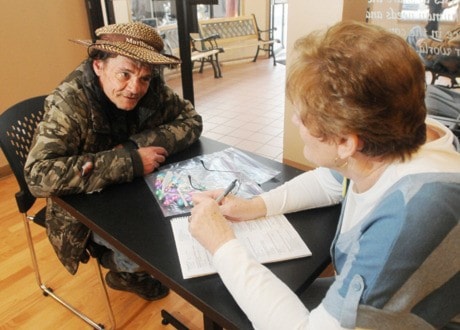Four days ago, Rob McGowan lost everything he owned. A tarp, a tent, his blanket, meagre possessions that could all fit in a small, battered shopping cart.
“The bylaw cops threw out everything,” said McGowan, dressed in a floppy straw hat, camouflage jacket, a oversized woolly sweater and muddy jeans.
“I get harassed because I know my rights as a Canadian citizen. People like to blame all society’s woes on the homeless.”
Three years ago, McGowan was one of 2,660 homeless people counted across Metro Vancouver – a tally that saw 22 per cent increase in that population from 2005.
Not much has changed for McGowan in that span. Despite several attempts, finding a home has proved difficult.
“I can’t find a place that I can afford or roommates I can depend on,” he said.
So McGowan shuffles between camps in the bushes and the Salvation Army’s Caring Place shelter, where there are beds available nearly year-around.
When Metro Vancouver conducted its last count in 2008, the number of homeless people in Maple Ridge and Pitt Meadows more than doubled from the previous one. Ninety people were found to be with no roof over their heads in the municipalities, up from 42 in 2005.
McGowan figures that tally will remain the same or maybe even increase this year.
“I’m just seeing more people who are homeless,” said McGowan, his face weathered and creased from eight years of hard living on the street. “There are more people unemployed, younger people and more families.”
More than 600 trained volunteers fanned out across the Lower Mainland on Wednesday to count the number of homeless people in a single, 24-hour snapshot.
In Maple Ridge, volunteers were stationed at the library, two bottle depots and the welfare office, while outreach workers visited a dozen outdoor camps.
The count also included people staying in homeless shelters and safe houses, as well as people with “no fixed address,” staying in hospitals, jails or other temporary transitional facilities.
“The 2011 Homeless Count is important not only because it provides a snapshot of the minimum number of people without a secure place to live,” explained Stephanie Ediger, executive director of the Alouette Home Start Society and the count co-ordinator in Maple Ridge, “because we count every three years. And because we collect important information in the survey, the count helps us better understand how the population is changing and what needs are emerging.”
The count looks to identify trends in homelessness by asking people living on the street their reasons for being homeless, how long they have been without a home, where they stay at night, and what services they use.
“The count is considered to be the absolute minimum number of homeless in the area,” said Ediger, adding it is impossible to record the “hidden homeless,” those who are living in their cars, hotels or couch-surfing.
Those without a home blame poverty and a lack of affordable housing in Maple Ridge and Pitt Meadows for their circumstances.
B.C. Housing will soon be breaking ground for a 46-suite project in Maple Ridge, intended to give those in drug or psychiatric programs a place to live for up to a year, with 24-hour supervision.
Ediger says that supportive housing will help, but it won’t help families or those who don’t suffer from addiction or mental health issues.
“It certainly won’t be the solution to the problem of homelessness, by any means. We need more affordable housing.”
Jenn Gash, a 29-year-old who has lived on the street on and off since she was 15, concurs.
“A one-bedroom in Maple Ridge cost $600. I can’t afford that,” she said.
She hopes this time, the regional tally, which has been conducted every three years since 2002, prompts real change.
“Maybe they will finally do something for the homeless,” she said.
Preliminary results from the count will be released in April, with a final report to follow in July.
Homeless count
• Men continue to dominate the homeless population, but homelessness among women is rising faster: men continue to make up a higher percentage of the homeless population than women, with 72 per cent compared to 27 per cent, respectively; in 2008, the number of women who were homeless increased by 16 percent from 2005, compared to an increase of 13 per cent among men.
• Reasons street/service homeless did not stay in a shelter: in 2008, about 32 per cent of the street homeless population indicated that they did not stay in a shelter because they disliked them. Reasons given for disliking shelters included bed bugs, cleanliness, restrictive rules, noise, theft, and limits on how long they could stay. Only two per cent expressed a preference to sleep outside.
• Aboriginal homelessness is still high and growing: while people of Aboriginal ancestry represent only about two per cent of Metro Vancouver’s census population, they comprised 32 per cent of the region’s homeless population during the 2008 count, an increase from 30 per cent in 2005.
• Rising incidence of complex health problems: in 2008, approximately 84 per cent of the homeless reported at least one health condition, including many disabling conditions such as addiction (61 per cent), mental illness (33 per cent), and physical disability (31 per cent).
– 2008 Metro Vancouver Homeless Count
